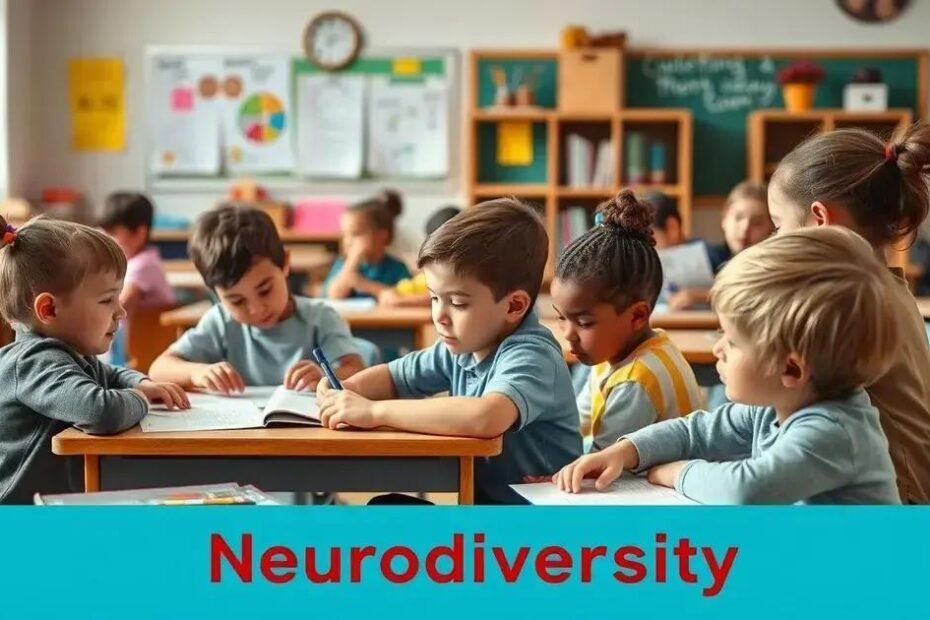Neurodiverse learning resources enhance educational experiences by providing tailored support and inclusive strategies, enabling all students to thrive academically and socially.
Neurodiverse learning resources play a crucial role in shaping educational experiences for all students. By embracing diverse learning styles, educators can create more inclusive spaces. Have you considered how diverse approaches can enhance comprehension and engagement?
Understanding neurodiversity in education
Understanding neurodiversity in education is essential for fostering an inclusive environment. Each student brings unique strengths and challenges, making it vital for educators to adapt their teaching methods. Recognizing these differences can lead to better academic outcomes and personal growth.
What is Neurodiversity?
Neurodiversity refers to the variety of neurological differences in human brains. This concept emphasizes strengths over weaknesses. Some common examples include:
- Autism Spectrum Disorder
- Attention Deficit Hyperactivity Disorder (ADHD)
- Dyslexia
- Dyspraxia
Each of these conditions presents a distinct way of processing information. For example, students with ADHD may excel in creative tasks but struggle with traditional learning methods. This is where educators can make a noticeable impact.
Importance of Inclusion
Inclusion in the classroom promotes acceptance. When teachers celebrate neurodiversity, they not only enhance learning but also create a sense of community. It’s crucial to involve all students in discussions and activities. An inclusive approach gives everyone a chance to shine.
Teachers can adopt various strategies to support neurodiverse learners. For instance, incorporating technology can provide interactive experiences that engage students more effectively. Visual aids, hands-on activities, and flexible seating arrangements also cater to different learning styles.
Benefits of Understanding Neurodiversity
By understanding neurodiversity, educators can:
- Improve student engagement
- Boost academic performance
- Encourage social skills
- Foster a safe learning environment
A classroom that values neurodiversity can minimize bullying and enhance peer relationships. When students learn about each other’s strengths and challenges, they develop empathy and better communication skills.
To summarize, understanding neurodiversity in education not only benefits neurodiverse students but enriches the learning experience for everyone. Ultimately, embracing these differences is key to creating well-rounded individuals prepared for the future.
Essential resources for teachers
Having the right resources is crucial for teachers to effectively support their neurodiverse students. Access to various tools and materials can significantly enhance the learning experience.
Types of Resources
There are many types of resources available to educators. These can be categorized into several key areas, including:
- Teaching Materials: Interactive books, visual aids, and digital content.
- Technology Tools: Software for organizing lessons and apps designed for neurodiverse learning.
- Professional Development: Workshops and training for teachers to understand neurodiversity better.
Teachers also benefit from networking with specialist organizations. Many groups offer training and resources specifically tailored for educating neurodiverse students.
Recommended Platforms and Organizations
Using reliable platforms can greatly influence teaching strategies. Some recommended ones include:
- Understood.org: Offers resources for educators and parents.
- Learning Ally: Provides audiobooks and learning support.
- TeachThought: Features innovative teaching ideas.
By engaging with these platforms, educators can discover creative approaches and tips. Implementing these resources fosters a more inclusive classroom.
Additionally, online courses can equip teachers with the knowledge needed to understand different learning styles better. Continuous learning is vital in adapting to students’ needs.
Utilizing these essential resources not only helps teachers to support neurodiverse learners effectively but also builds a stronger educational framework. This, in turn, encourages a positive learning environment for all students.
Techniques to engage neurodiverse learners

Engaging neurodiverse learners requires innovative techniques that cater to their unique learning styles. By adopting specific strategies, educators can create an environment that promotes understanding and growth for every student.
Variety of Teaching Methods
One effective way to engage students is by using a mix of teaching methods. This ensures that all learners connect with the material. Consider implementing:
- Visual aids: Charts, graphs, and images help students grasp concepts better.
- Hands-on activities: These methods allow learners to experiment and explore.
- Storytelling: Sharing stories can make lessons memorable and relatable.
Additionally, using technology can enhance engagement. Interactive apps and educational games promote motivation and interaction among students.
Flexible Learning Environments
Creating a flexible classroom environment can also benefit neurodiverse learners. Allowing students to choose how they learn and where they sit can help them feel comfortable. Offering options like:
- Quiet spaces for focused work
- Group settings for collaborative projects
- Movement breaks to reset energy levels
Moreover, enabling students to express their preferences empowers them and encourages participation. When learners feel comfortable, they are more likely to engage fully in class activities.
Another technique is to incorporate frequent feedback. Constructive feedback helps guide students and reinforces learning. This creates a supportive atmosphere where students can thrive.
Ultimately, the goal is to foster an inclusive classroom where all students can flourish. By using these strategies, educators can better support neurodiverse learners and enhance their educational experiences.
Creating inclusive learning environments
Creating inclusive learning environments is vital for all students, especially those who are neurodiverse. An inclusive setting encourages every student to participate fully and thrive in their education.
Flexible Classroom Design
The physical layout of the classroom plays a big role in inclusivity. Consider designing spaces that promote interaction and focus. For example,:
- Flexible seating: Allow students to choose their seating to enhance comfort and focus.
- Quiet zones: Create areas where students can retreat to work independently.
- Interactive learning stations: Set up different areas for hands-on activities and group discussions.
This variety helps cater to different learning styles while making the classroom more welcoming.
Encouraging Collaboration
Collaboration among students is key to fostering acceptance and understanding. Group work and peer tutoring can be beneficial. Encouraging students to share their strengths allows for:
- Development of social skills
- Enhanced learning opportunities
- Greater acceptance of differences
Additionally, creating mixed groups that include neurodiverse learners promotes empathy and teamwork. When students work together, they learn valuable interpersonal skills.
It’s also important to implement clear expectations and instructions. Using visual schedules or checklists can help neurodiverse students understand and follow classroom routines more easily. This structure can reduce anxiety and improve focus.
By creating a welcoming environment, filled with diverse activities and collaborative opportunities, educators can ensure that all students feel valued. An inclusive classroom is one where differences are celebrated, and everyone has a chance to succeed.
Supporting parents of neurodiverse children
Supporting parents of neurodiverse children is essential for their children’s success and well-being. Parents often face unique challenges, and having the right support can make a significant difference.
Providing Resources and Information
One vital way to support parents is by offering resources. Parents need access to information about neurodiversity and its impacts. Providing resources can include:
- Educational materials: Books and articles that explain various conditions.
- Webinars and workshops: Sessions that help parents learn about strategies and tools.
- Support groups: Connecting parents with others in similar situations for shared experiences and advice.
These resources can equip parents with knowledge to advocate for their children effectively.
Encouraging Open Communication
Open communication between educators and parents is crucial. It allows for a collaborative approach to each child’s education. Regular check-ins can help parents stay informed about their child’s progress. By fostering a partnership, educators can:
- Share strategies that work in the classroom
- Discuss any concerns or challenges
- Celebrate successes together
When parents feel involved, they are more likely to support their child at home, reinforcing what is learned in school.
Additionally, schools can provide personalized support plans. These plans should outline accommodations and resources available for the child. This ensures that both parents and educators are aligned on strategies to support learning.
By focusing on these key areas, schools can strengthen their partnership with families. Supporting parents of neurodiverse children builds a foundation for success and helps create a nurturing environment for children to thrive.
FAQ – Frequently Asked Questions about Supporting Neurodiverse Learners
What are some effective strategies for engaging neurodiverse learners?
Utilizing a mix of teaching methods, flexible seating arrangements, and interactive activities can significantly enhance engagement.
How can parents support their neurodiverse children at home?
Parents can reinforce learning by providing a supportive environment, using resources for education, and maintaining open communication with schools.
What role does technology play in supporting neurodiverse students?
Technology provides interactive tools and resources that cater to diverse learning styles, making learning more accessible and engaging for neurodiverse students.
How can schools create a more inclusive environment?
By designing flexible classroom spaces, promoting collaboration, and providing ongoing training for staff on neurodiversity, schools can foster a more inclusive atmosphere.

